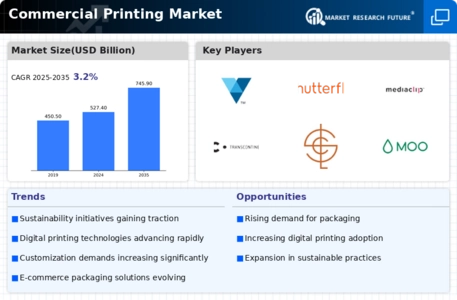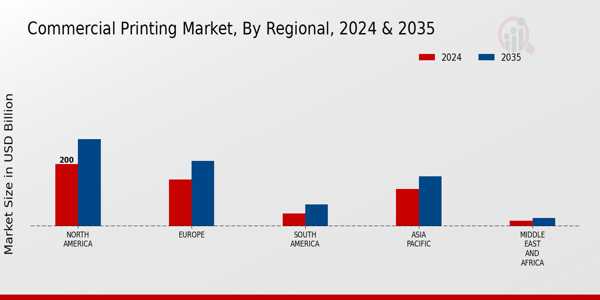E-commerce Growth
The rise of e-commerce is significantly impacting the Global Commercial Printing Market Industry. As online retail continues to flourish, there is an increasing need for printed materials such as packaging, labels, and promotional materials. E-commerce businesses often require customized solutions to enhance their branding and customer experience. This demand is likely to drive growth in the commercial printing sector, as companies seek to differentiate themselves in a competitive landscape. The anticipated compound annual growth rate of 3.2% from 2025 to 2035 reflects the potential of this sector to capitalize on the expanding e-commerce market.
Globalization of Markets
Globalization is reshaping the Global Commercial Printing Market Industry by facilitating access to international markets. As businesses expand their operations globally, the demand for printed materials in various languages and formats increases. This trend necessitates the establishment of efficient supply chains and distribution networks to meet diverse customer needs. Companies that can adapt to these global demands are likely to gain a competitive advantage. Furthermore, the interconnectedness of markets may lead to collaborative ventures, enhancing innovation and service offerings within the industry. This dynamic environment is expected to contribute to the overall growth of the market.
Market Growth Projections
The Global Commercial Printing Market Industry is poised for substantial growth, with projections indicating a market size of 527.4 USD Billion in 2024 and an anticipated increase to 745.9 USD Billion by 2035. This growth trajectory suggests a compound annual growth rate of 3.2% from 2025 to 2035. Such figures underscore the industry's resilience and adaptability in the face of changing consumer demands and technological advancements. The market's expansion is likely to be driven by various factors, including the rise of e-commerce, sustainability initiatives, and the increasing need for customized printing solutions.
Sustainability Initiatives
Sustainability initiatives are becoming increasingly pivotal within the Global Commercial Printing Market Industry. Companies are adopting eco-friendly practices, such as using recycled materials and sustainable inks, to meet consumer demand for environmentally responsible products. This shift not only aligns with global sustainability goals but also enhances brand reputation. For example, several printing firms are investing in energy-efficient machinery and sustainable supply chains. This trend is likely to attract environmentally conscious clients, thereby expanding market opportunities. The industry's commitment to sustainability could play a crucial role in achieving a projected market value of 745.9 USD Billion by 2035.
Technological Advancements
The Global Commercial Printing Market Industry is experiencing a notable transformation driven by technological advancements. Innovations such as digital printing, automation, and artificial intelligence are enhancing efficiency and reducing production costs. For instance, digital printing allows for shorter print runs and faster turnaround times, catering to the growing demand for personalized products. As a result, businesses can respond swiftly to market changes, potentially increasing their competitive edge. The integration of these technologies is expected to contribute to the market's growth, with projections indicating a market size of 527.4 USD Billion in 2024.
Customization and Personalization Trends
Customization and personalization trends are becoming increasingly prominent in the Global Commercial Printing Market Industry. Consumers are seeking unique products that reflect their individual preferences, prompting businesses to offer tailored printing solutions. This demand for personalized items, such as custom packaging and promotional materials, is driving innovation within the sector. Companies that can effectively leverage data analytics to understand consumer behavior are likely to thrive in this evolving landscape. The ability to provide customized solutions not only enhances customer satisfaction but also fosters brand loyalty, potentially leading to increased market share.

















Leave a Comment